Since galaxy season is approaching I'm trying to work out the best approach under my light polluted skies shooting OSC. I've had some success using a very broad light pollution filter but the result may as well be monochrome as far as any useful color is concerned. I've also had some interesting results with brighter objects such as m31 and m33 by just using a dual band filter. I really don't want to really blow up the Ha as I see done so often using continuum subtraction techniques but am after something a bit more natural and balanced. I have tried using just a uv/ir cut but it's impossible to balance out the color from the LP. I'm open to any ideas that don't involve going to a darker location or using PI 
I don't think I've exactly failed. I am more interested in what the options are. Dual band works and is interesting with bright close by objects that have a lot of Ha, just takes rather long integrations. I tried just going with a uv/ir a few nights ago but wide band LP the color crossover was horrible and uncorrectable. The best solution I've found so far is a with a wide band LP filter as it does a good job of taming my LP a bit but color is hard to come by. I'm wondering if one of the triband filters that have rather wide band passes would be worth go?
Tony Gondola:
I don't think I've exactly failed. I am more interested in what the options are. Dual band works and is interesting with bright close by objects that have a lot of Ha, just takes rather long integrations. I tried just going with a uv/ir a few nights ago but wide band LP the color crossover was horrible and uncorrectable. The best solution I've found so far is a with a wide band LP filter as it does a good job of taming my LP a bit but color is hard to come by. I'm wondering if one of the triband filters that have rather wide band passes would be worth go?
I imaged this in my Bortle 8 backyard in Portland Oregon
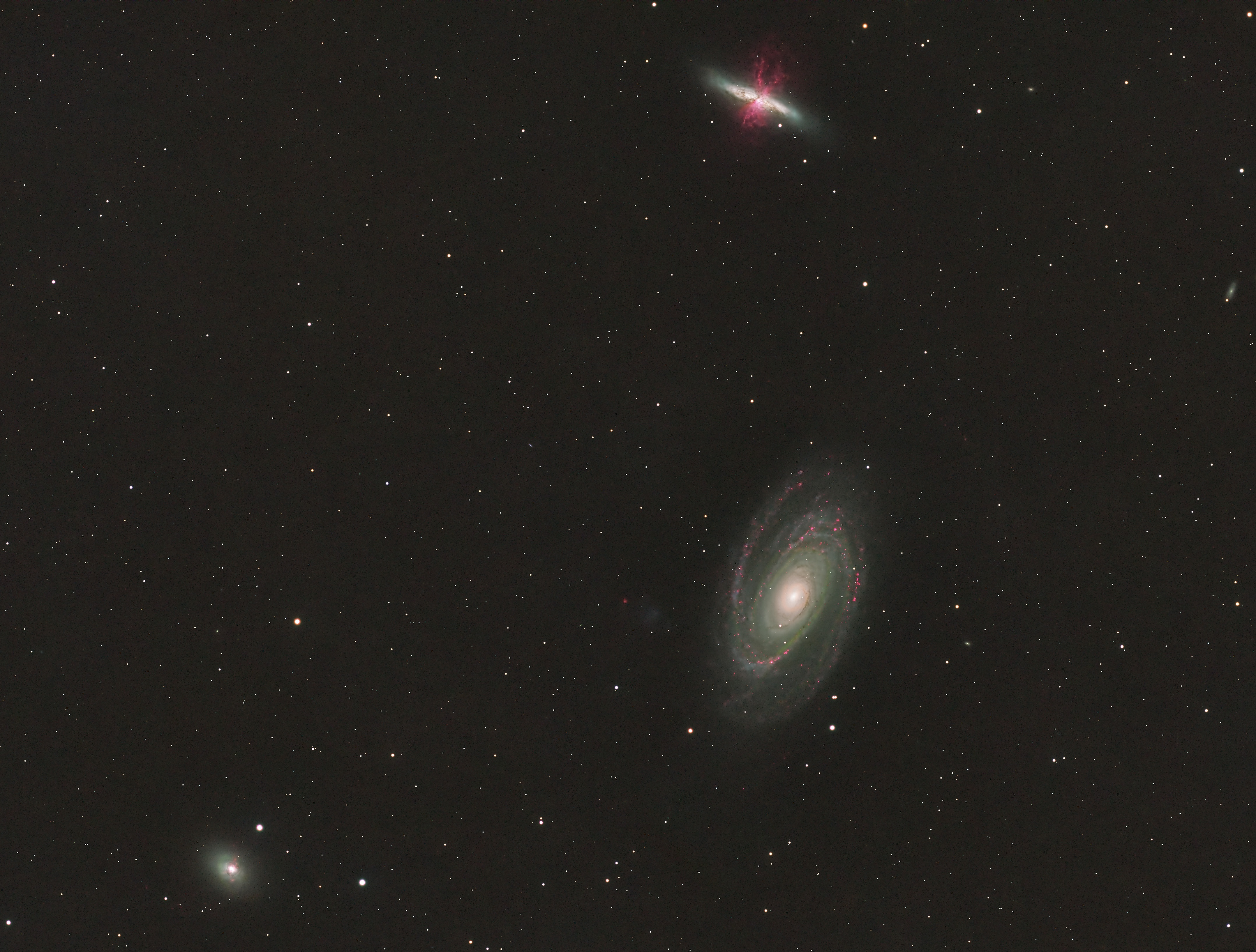 last April with a 2600mc and a Radian Triad Ultra Filter (No longer available but there are a lot similar)
last April with a 2600mc and a Radian Triad Ultra Filter (No longer available but there are a lot similar)I think this was about 30 hours.
Not award winning but doable in the City
The Antlia Tri-Band filter alone produces some nice results with galaxies, and would probably be an improvement over your LP filter because it has tighter band passes than most LP filters. Plus, as far as filters go, the Tri-Band is relatively inexpensive by comparison, so it would certainly be worth a try!
Well Written Concise
Not the answer you are looking for, but the only cure for light polluted broadband imaging is integration time. And by that i mean you should target a real mountain of data, im talking 20h+ for a decent result. As for general purpose "light pollution filters", these just simply do not work, and can not work, for broadband imaging. Reason being that modern light pollution and the average light coming from galaxies is more or less the same so blocking LP will also block signal and vice versa (=pointless). By the way UV/IR color calibration is perfectly doable from light polluted skies, you just need to get the signal to noise ratio to a point where it can work and make the image presentable.
I know you wrote you are not open to traveling to darker skies, but why not? Really it is the most sane option if you want to image galaxies in broadband. You get roughly 2.5x the SNR per magnitude of sky darker, so drive out of the city to a location that is 2 magnitudes better and you get an equivalent/better SNR to that of 36 hours from your home skies for an average night of 6 hours data gathered. Manage to find skies that are 3 magnitudes darker and you are practically swimming in signal to noise ratio.
I know you wrote you are not open to traveling to darker skies, but why not? Really it is the most sane option if you want to image galaxies in broadband. You get roughly 2.5x the SNR per magnitude of sky darker, so drive out of the city to a location that is 2 magnitudes better and you get an equivalent/better SNR to that of 36 hours from your home skies for an average night of 6 hours data gathered. Manage to find skies that are 3 magnitudes darker and you are practically swimming in signal to noise ratio.
Helpful Insightful Engaging
I'm not about to win any APODs, but I've been successful enough shooting galaxies in Bortle 8/9 skies that I continue to enjoy it. I am most successful when I:
1. Shoot far from the moon! (Choose nights with <50% illumination, far away in angular distance.)
2. Choose a filter wisely. I've had the best luck with a) the Antlia Triband; and b) the Optolong L-Quad eNhance.
3. Accumulate lots of integration time, generally exceeding 12 hours.
Below are a few photos of results in Bortle 8/9 skies--I hope this helps!
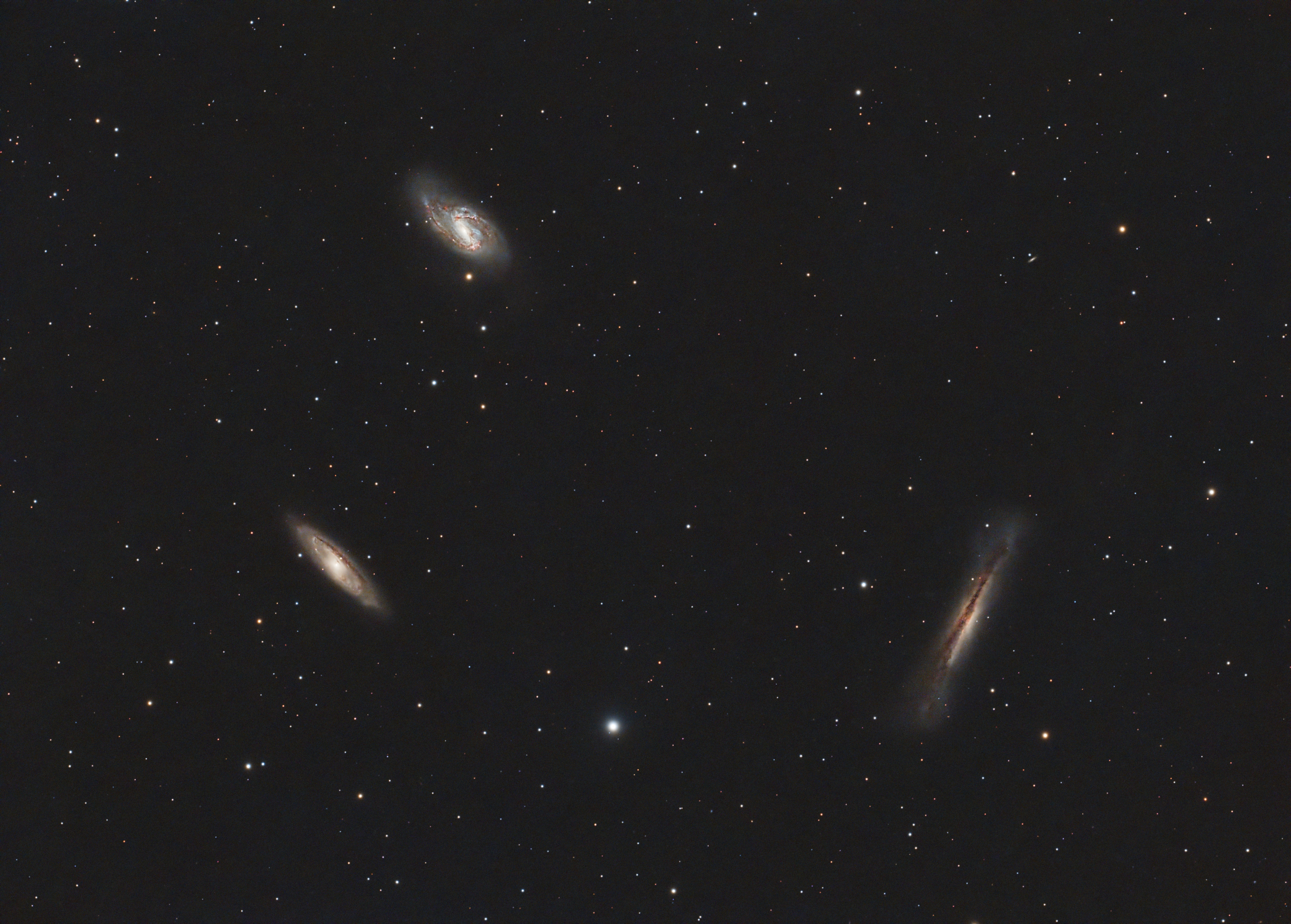
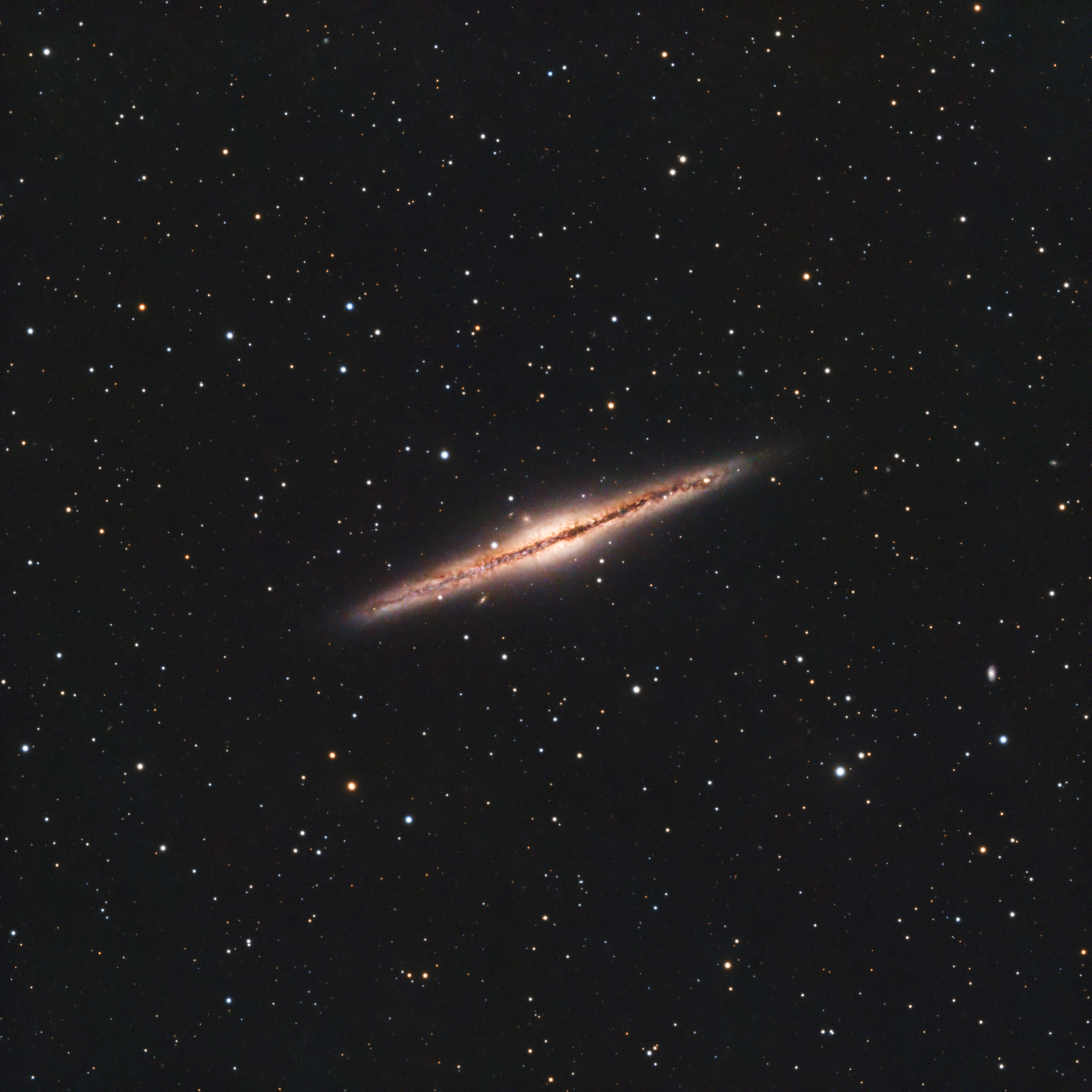
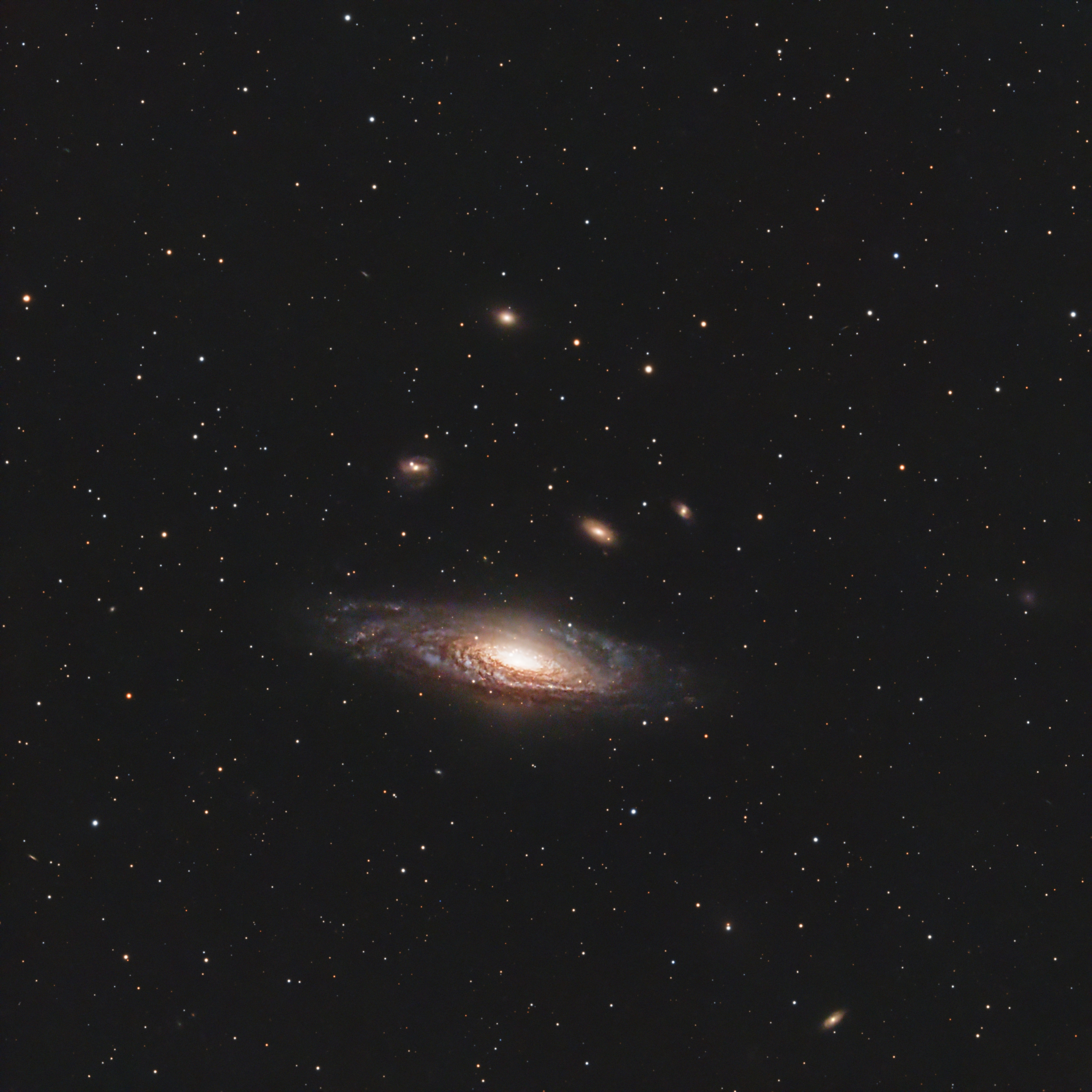
1. Shoot far from the moon! (Choose nights with <50% illumination, far away in angular distance.)
2. Choose a filter wisely. I've had the best luck with a) the Antlia Triband; and b) the Optolong L-Quad eNhance.
3. Accumulate lots of integration time, generally exceeding 12 hours.
Below are a few photos of results in Bortle 8/9 skies--I hope this helps!



Well Written Helpful Insightful Engaging Supportive
Tony Gondola:
Since galaxy season is approaching I'm trying to work out the best approach under my light polluted skies shooting OSC. I've had some success using a very broad light pollution filter but the result may as well be monochrome as far as any useful color is concerned. I've also had some interesting results with brighter objects such as m31 and m33 by just using a dual band filter. I really don't want to really blow up the Ha as I see done so often using continuum subtraction techniques but am after something a bit more natural and balanced. I have tried using just a uv/ir cut but it's impossible to balance out the color from the LP. I'm open to any ideas that don't involve going to a darker location or using PI
Which filter are you currently using? I’ve been very happy with the Optolong L-Pro, but I’m not in a Bortle 8, so maybe the quality drops off…
In the last year, Optolong release the L-Quad, but I don’t know how that compares to the L-Pro.
Well Written Engaging
I thank everyone for the input. The images posted here and results I've had so far are making me hopeful. I'll have to do a detailed study of them but it seems that a tri or quad band filter will really help. That and a lot more integration time. I know driving to a darker sky would help but honestly, I like the challenge and working from the backyard has so many advantages for me, like sleep! I'm serious about the hobby but I also want it to be fun and relaxing, going mobile just isn't that for me.
Well Written Respectful Engaging
M82, Bortle 8, 15.6hours, Optolong L-Quad Enhance
PixInsight
Final curves and additional sharpening/NR in Adobe Photoshop
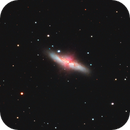
M82 (Cigar Galaxy) January 2025
PixInsight
- GraXpert
- BlurXT (correct only)
- SPCC
- GHS stretch
- StarXT
- Masked secondary GHS stretch
- AsinH stretch
- HDR multiscale transform
- Stars + starless recombination (PixelMath)
- BlurXT sharpening
- Color Saturation increase
Final curves and additional sharpening/NR in Adobe Photoshop

M82 (Cigar Galaxy) January 2025
I have good Results with Newtonian and NO Filter als luminance.
i use an imx585 ir sensitive Camera
dont Choice a Long subexposure, Max 15-30
i use an imx585 ir sensitive Camera
dont Choice a Long subexposure, Max 15-30
Dan Kearl:Tony Gondola:
I don't think I've exactly failed. I am more interested in what the options are. Dual band works and is interesting with bright close by objects that have a lot of Ha, just takes rather long integrations. I tried just going with a uv/ir a few nights ago but wide band LP the color crossover was horrible and uncorrectable. The best solution I've found so far is a with a wide band LP filter as it does a good job of taming my LP a bit but color is hard to come by. I'm wondering if one of the triband filters that have rather wide band passes would be worth go?
I imaged this in my Bortle 8 backyard in Portland Oregonlast April with a 2600mc and a Radian Triad Ultra Filter (No longer available but there are a lot similar)
I think this was about 30 hours.
Not award winning but doable in the City
30 hours is a big commitment but fortunately your image looks amazing
Tony Gondola:
Since galaxy season is approaching I'm trying to work out the best approach under my light polluted skies shooting OSC. I've had some success using a very broad light pollution filter but the result may as well be monochrome as far as any useful color is concerned. I've also had some interesting results with brighter objects such as m31 and m33 by just using a dual band filter. I really don't want to really blow up the Ha as I see done so often using continuum subtraction techniques but am after something a bit more natural and balanced. I have tried using just a uv/ir cut but it's impossible to balance out the color from the LP. I'm open to any ideas that don't involve going to a darker location or using PI
Cuiv the lazy geek does alright from Tokyo. You'll be fine
Jochen Schambach:
I have good Results with Newtonian and NO Filter als luminance.
i use an imx585 ir sensitive Camera
dont Choice a Long subexposure, Max 15-30
That's the one thing I haven't tried. I generally do 15 sec. subs with that sensor so it's worth a go.
Leo Triplet from the Suburbs (Guillermo de Miranda) - AstroBin
I took this one a couple of years back from a bortle 7 location ( my backyard) without a filter and without a cooled camera. So it's definitely possible. You don't need to do 15 second subs unless you have very fast optics. I have since bought an L-Pro and feel that it does help a bit, it's definitely one of these things you need to try out for yourself and see what works best. You can always sell it.
Travelling to dark skies is also not always practical, so making imaging work from home should always be a top priority.
I took this one a couple of years back from a bortle 7 location ( my backyard) without a filter and without a cooled camera. So it's definitely possible. You don't need to do 15 second subs unless you have very fast optics. I have since bought an L-Pro and feel that it does help a bit, it's definitely one of these things you need to try out for yourself and see what works best. You can always sell it.
Travelling to dark skies is also not always practical, so making imaging work from home should always be a top priority.
Helpful Supportive
https://app.astrobin.com/i/42hzba
Here's a link to my image of the Hidden Galaxy with the 533MC Pro and Antlia Tri-Band toward the most light polluted portion of the sky (which is a major city to the North, but I'm far enough out that it's probably more like Bortle 6-7 for me when I shoot that direction. The Zenith is Bortle 5ish, and South is probably closer to Bortle 4 for me.)
I figured I'd try 2 min exposures instead of my usual 3 min exposures to try to mitigate LP, but I don't think had much of an impact either way, as I recently shot M81 and M82 in that same direction with 3 min exposures and those came out nicely.
Here's a link to my image of the Hidden Galaxy with the 533MC Pro and Antlia Tri-Band toward the most light polluted portion of the sky (which is a major city to the North, but I'm far enough out that it's probably more like Bortle 6-7 for me when I shoot that direction. The Zenith is Bortle 5ish, and South is probably closer to Bortle 4 for me.)
I figured I'd try 2 min exposures instead of my usual 3 min exposures to try to mitigate LP, but I don't think had much of an impact either way, as I recently shot M81 and M82 in that same direction with 3 min exposures and those came out nicely.
I managed to image IC 342 about a week ago. The weather was closing in so I only got about 1.3 hrs of useable data. This was with the Lumicon Deep Sky Filter, 585 sensor 150mm newt at F/6. It needs a lot more time but I think I'm on the right path. Just needs a lot more time so I can hopefully get more star color and do a deeper cull to improve the resolution.
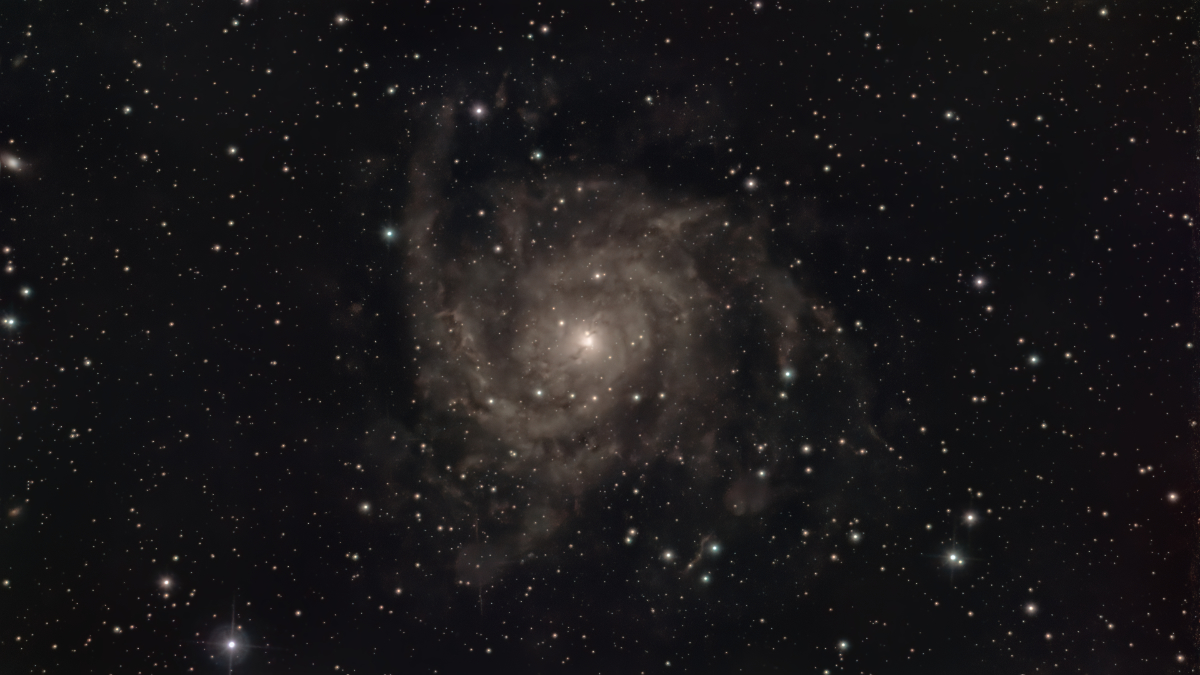

Helpful
Oskari Nikkinen:
Not the answer you are looking for, but the only cure for light polluted broadband imaging is integration time. And by that i mean you should target a real mountain of data, im talking 20h+ for a decent result. As for general purpose "light pollution filters", these just simply do not work, and can not work, for broadband imaging. Reason being that modern light pollution and the average light coming from galaxies is more or less the same so blocking LP will also block signal and vice versa (=pointless). By the way UV/IR color calibration is perfectly doable from light polluted skies, you just need to get the signal to noise ratio to a point where it can work and make the image presentable.
I know you wrote you are not open to traveling to darker skies, but why not? Really it is the most sane option if you want to image galaxies in broadband. You get roughly 2.5x the SNR per magnitude of sky darker, so drive out of the city to a location that is 2 magnitudes better and you get an equivalent/better SNR to that of 36 hours from your home skies for an average night of 6 hours data gathered. Manage to find skies that are 3 magnitudes darker and you are practically swimming in signal to noise ratio.
I see your point, but I also know from experience that some of us still want to image and are stuck at home.
My options to go to darker skies are maybe 6 times a year, but I can go outside my house 5 times a week.
I have had good luck with shorter exposures and lots of subs. In my bortle 7, the magic spot is around 60 seconds on a good night and usually 45 seconds on an average night.
I have a decent idas lps filter that seems to do OK, I do get a color cast, but its fixable in pixinsight.
Here is how I do the math to feel better about not traveling. This will upset the "only in dark skies cult"
Let say I tell my wife I am going to take 4 hours and go imaging, I know its a work night but I will take the hit.
I can do
Option A
Pack up the car with all my gear 10 minutes
Drive to another location 45 minute
Unpack and setup 15 minutes
Polar Align and get going 15 minutes
Image for 1.5 hours
Load it back in the car 15 minutes
Drive home 45 minutes
Unload and put away 10 minutes
Total 4.0 hours (give or take)
Total imaging 1.5 hours
Or
Option B
Haul my stuff outside 5 minutes
Polar Align and get going 15 minutes
Image for 3.5 hours
Haul it back inside 15 minutes
Total 4.0 hours
Total Imaging 3.5 hours
I am sure the sky/light at option A is at least twice as good as option B. But lets lets not pretend I get near as much imaging time.
And
Option A Will likely cost me gas money and 20$ in soda and snacks while I sit out in the cold desert alone (sometimes this could be a good thing)
Option B I can chill outside until Im bored, go back inside, watch TV, play PS5, be with family etc.
Option B I can pull off 5x a week without causing marriage drama.
Option A I can pull of maybe once a month.
There is a whole squad that would argue "if you are a die hard, serious guy, you need to go do dark sites", I would argue "die hard serious guys do it every night" and only "lucky guys do it every night in ideal locations".
Galaxies, in Bortle 8,
Get a decent filter that does some led blocking
Take lots of shorter exposures
Stay patient, enjoy it, you wont get your image as fast as the guys heading out to dark skies, but you are managing a balance of what you can and cant do.
Sometimes I wish our images showed the rest of the stuff we were juggling in life while we pulled it off.
Helpful Engaging Supportive
To add to Clayon's math it gets even better. I leave my mount outside so there's no need to PA every night. All I have to do to get up and running is flip a power switch, mount the OTA, run inside and connect to the scope and I'm ready to go. It take me in total about 5 min. If I get the scope out early, it's already cooled down when it's dark enough to image. If I have more then one good night in a row I just bag the rig with the OTA in place so it's even faster then next night.
I use NINA so it's all automated. I can load up a sequence that automatically starts at a defined time and runs all night. In the winter, if the object is placed well, I can easily get 6 to 7 hours in. I can go to bed, watch a movie or even go out to dinner (yes, I've done it). In the morning the scope is parked but everything is still running. It's a simple matter of a few min. to shoot my sky flats and I'm done. It's an extremely efficient way to work.
I use NINA so it's all automated. I can load up a sequence that automatically starts at a defined time and runs all night. In the winter, if the object is placed well, I can easily get 6 to 7 hours in. I can go to bed, watch a movie or even go out to dinner (yes, I've done it). In the morning the scope is parked but everything is still running. It's a simple matter of a few min. to shoot my sky flats and I'm done. It's an extremely efficient way to work.
Helpful Engaging Supportive
Tony Gondola:
To add to Clayon's math it gets even better. I leave my mount outside so there's no need to PA every night. All I have to do to get up and running is flip a power switch, mount the OTA, run inside and connect to the scope and I'm ready to go. It take me in total about 5 min. If I get the scope out early, it's already cooled down when it's dark enough to image. If I have more then one good night in a row I just bag the rig with the OTA in place so it's even faster then next night.
I use NINA so it's all automated. I can load up a sequence that automatically starts at a defined time and runs all night. In the winter, if the object is placed well, I can easily get 6 to 7 hours in. I can go to bed, watch a movie or even go out to dinner (yes, I've done it). In the morning the scope is parked but everything is still running. It's a simple matter of a few min. to shoot my sky flats and I'm done. It's an extremely efficient way to work.
Tony and I dont know each other, but I think we would get along great. I went back and evaluated my last trip do darker skies, I left at 10pm returned at 5 am and picked up 2hrs and 20 minutes of data. (and an upset wife). ahahhah
Charles Hagen IOTD Staff
Feb 10, 2025
Tony Gondola:
I have tried using just a uv/ir cut but it's impossible to balance out the color from the LP. I'm open to any ideas that don't involve going to a darker location or using PI
From a practical perspective I am not seeing how light pollution would have any effect on the color of your target so long as you are using something like background neutralization. Light pollution is purely additive. Furthermore, I find that for galaxies, modeling and subtracting light pollution gradients is particularly easy. With this in mind, it should be trivial to perform gradient subtraction, then background neutralization, and have the exact same color (albeit with more noise) than you would in any other location.
My recommendation is to always just use a UV/IR cut filter to achieve as natural of colors as possible and the best SNR possible. I find that people often observe the increased contrast from LP filters and extrapolate it to mean better or less noisy data, which I have seen no empirical evidence for. The math seems to check out that UV/IR cut filters provide the best SNR and the least altered colors despite the higher absolute transmission of light pollution signal.
Well Written Helpful Insightful Engaging Supportive
Charles Hagen:Tony Gondola:
I have tried using just a uv/ir cut but it's impossible to balance out the color from the LP. I'm open to any ideas that don't involve going to a darker location or using PI
From a practical perspective I am not seeing how light pollution would have any effect on the color of your target so long as you are using something like background neutralization. Light pollution is purely additive. Furthermore, I find that for galaxies, modeling and subtracting light pollution gradients is particularly easy. With this in mind, it should be trivial to perform gradient subtraction, then background neutralization, and have the exact same color (albeit with more noise) than you would in any other location.
My recommendation is to always just use a UV/IR cut filter to achieve as natural of colors as possible and the best SNR possible. I find that people often observe the increased contrast from LP filters and extrapolate it to mean better or less noisy data, which I have seen no empirical evidence for. The math seems to check out that UV/IR cut filters provide the best SNR and the least altered colors despite the higher absolute transmission of light pollution signal.
Thanks for the input Charles. I don't have trouble with backgrounds or gradients but am having a lot of difficulty bring up the star colors. In my old DSLR days, getting good star color was trivial so this is something new. Obviously I have more experimenting to do and I'll give the UV/IR cut another go.
Clayton Ostler:Oskari Nikkinen:
Not the answer you are looking for, but the only cure for light polluted broadband imaging is integration time. And by that i mean you should target a real mountain of data, im talking 20h+ for a decent result. As for general purpose "light pollution filters", these just simply do not work, and can not work, for broadband imaging. Reason being that modern light pollution and the average light coming from galaxies is more or less the same so blocking LP will also block signal and vice versa (=pointless). By the way UV/IR color calibration is perfectly doable from light polluted skies, you just need to get the signal to noise ratio to a point where it can work and make the image presentable.
I know you wrote you are not open to traveling to darker skies, but why not? Really it is the most sane option if you want to image galaxies in broadband. You get roughly 2.5x the SNR per magnitude of sky darker, so drive out of the city to a location that is 2 magnitudes better and you get an equivalent/better SNR to that of 36 hours from your home skies for an average night of 6 hours data gathered. Manage to find skies that are 3 magnitudes darker and you are practically swimming in signal to noise ratio.
I see your point, but I also know from experience that some of us still want to image and are stuck at home.
My options to go to darker skies are maybe 6 times a year, but I can go outside my house 5 times a week.
I have had good luck with shorter exposures and lots of subs. In my bortle 7, the magic spot is around 60 seconds on a good night and usually 45 seconds on an average night.
I have a decent idas lps filter that seems to do OK, I do get a color cast, but its fixable in pixinsight.
Here is how I do the math to feel better about not traveling. This will upset the "only in dark skies cult"
Let say I tell my wife I am going to take 4 hours and go imaging, I know its a work night but I will take the hit.
I can do
Option A
Pack up the car with all my gear 10 minutes
Drive to another location 45 minute
Unpack and setup 15 minutes
Polar Align and get going 15 minutes
Image for 1.5 hours
Load it back in the car 15 minutes
Drive home 45 minutes
Unload and put away 10 minutes
Total 4.0 hours (give or take)
Total imaging 1.5 hours
Or
Option B
Haul my stuff outside 5 minutes
Polar Align and get going 15 minutes
Image for 3.5 hours
Haul it back inside 15 minutes
Total 4.0 hours
Total Imaging 3.5 hours
I am sure the sky/light at option A is at least twice as good as option B. But lets lets not pretend I get near as much imaging time.
And
Option A Will likely cost me gas money and 20$ in soda and snacks while I sit out in the cold desert alone (sometimes this could be a good thing)
Option B I can chill outside until Im bored, go back inside, watch TV, play PS5, be with family etc.
Option B I can pull off 5x a week without causing marriage drama.
Option A I can pull of maybe once a month.
There is a whole squad that would argue "if you are a die hard, serious guy, you need to go do dark sites", I would argue "die hard serious guys do it every night" and only "lucky guys do it every night in ideal locations".
Galaxies, in Bortle 8,
Get a decent filter that does some led blocking
Take lots of shorter exposures
Stay patient, enjoy it, you wont get your image as fast as the guys heading out to dark skies, but you are managing a balance of what you can and cant do.
Sometimes I wish our images showed the rest of the stuff we were juggling in life while we pulled it off.
I totally get your point and OPs stance on this. I am pushy about this subject because i get the feeling that some people need that small push to get them hooked to darksite imaging or at least try it out whenever an opportunity presents itself. I was one such person in the past (and am totally hooked now). Its not for everyone, the logistics really dont work out if there is a limited amount of time to image.
The imager in question needs to weigh the odds themselves and see if it can even technically work, and in your case option A really does not. I am in a somewhat lucky situation that i am a natural late sleeper, so imaging time does not really cut into my sleep schedule. Most 9-5 folks would probably find option B too much of a chore to do "full time". In my case i can usually spare at least 5, sometimes 6 or 7 hours for the trip so the odds are greatly in favour of traveling. Also, i dont really have a backyard so i have to haul my kit somewhere anyway, might as well drive a bit further to better skies.
Helpful Insightful Respectful Engaging